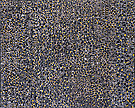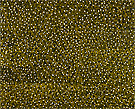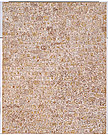Maria ORSTO

I find more life in doing artwork. My father, Declan Apuatimi, taught me to paint and carve. I am happy that I became an artist. My designs are growing stronger. I am always building up a new design in my head—sometimes I combine old Tiwi designs with my new ones.
Young eyes represent old ways with our new designs. Maria Josette Orsto, 2009[1]
The art and culture of the Tiwi people are distinct from those of mainland Aboriginal Australia. Their rich visual language has its origins in traditional body designs and elaborate ritual objects made for ceremony. The Tiwi people have two major ceremonies: Kulama (initiation) and Pukumani (mortuary).
The beautiful designs associated with these ceremonies often consist of bold blocks of textured earth pigments, red, yellow, white and black, applied elaborately onto the bodies of ceremonial participants in an effort to disguise the identity of the individual. Other ceremonial paraphernalia—false beards, headdresses, goose-feathered necklaces, armbands—are also made and worn by performers in an attempt to add drama to the ritual. The participants are cloaked in these ritual objects and body designs in an attempt to ensure the participant’s identity is hidden from the spirit of the deceased. The Tiwi believe that if the deceased’s spirit recognises the participants during the ceremony then the spirit would follow them back to their community and be forever lost in the world of the living. This is why the participants’ identities are hidden during the performance, and why disclosure occurs only after the ritual is complete.
The Pukumani ceremony consists of an elaborate cycle of rituals that specifically ensures the correct and safe passage of the deceased into the spirit realm. Large sculptured poles called ‘tutini’ are carved and decorated in this same graphic style and act as grave posts or markers for the deceased. Sometimes these poles feature a figurative element—buffalo heads, human faces, birds—referencing ancestral figures from the Dreaming.
Maria Josette Orsto is the daughter of Declan Apuatimi and Jean Baptiste Apuatimi. She was just six years old when the Tiwi Design art cooperative was established on the Tiwi Islands in 1968. Orsto was taught to paint and carve by her father and was the first female artist to become a formal member of the cooperative. She began by assisting her father, and she is recognised today as a versatile and prolific artist who works in a variety of media and techniques, including painting, batik-printmaking and wood sculpture.
Orsto’s painting style has developed over several decades. Initially, her work reflected her father’s bold style. Recently, however, she has developed a more subtle, subdued, feminine and seductive style of painting. Small dots and lines intimately positioned across the canvas give detailed impressions of the surface of an object or the land or reference the surface of the spiritual realm. Her work alludes to the small glimpses of power, sheen and shimmer of the ancestral realm.
The surface of Jikapayinga (Female crocodile) 2007 radiates a sense of the armoured skin of the crocodile, the ever-present predator of the north. These animals have their beginnings in the Dreaming and Orsto provides us with a glimpse of the protective skin of the prehistoric beast.
In Pakitiringa (Rain) 2007, Orsto has captured the impenetrable darkness of an afternoon monsoonal shower. The heaviness and density of the tropical downpour competes with the struggling afternoon sun. A restricted palette and fine-detailed parallel and diagonal zigzag patterns of small yellow dots evoke the rhythmic dancing rain as it is swept to and fro by the powerful driving force of the wind.
The intoxicating lightness of Miyinga 2009 is a direct reference to the powerful shimmer of a pearl shell, the whispering trail of rising smoke and deep melodic meditations of a Kulama ceremonial dance. For the Tiwi the yampatukuni (pearl shell) holds a special place in ritual and everyday life: the oyster meat is a source of food, the shine of the shell is associated with spirituality and rain and songs sung during the Kulama honour yampatukuni. The artist has expertly captured these elements by using a white background with finely layered yellow-, red- and grey-ochred patterns across the surface of the painting. Kulama dance circles emerge and submerge, disclose and undisclose, disguise, conceal and reveal ancestral knowledge, just as Orsto’s painted marks appear and disappear into the fabric of the canvas.
Franchesca Cubillo
[1] ‘Maria Josette Orsto’, artist statement for her work in the exhibition 26th Telstra National Aboriginal and Torres Strait Islander Art Award, Museum and Art Gallery of the Northern Territory, Darwin, 2009.



